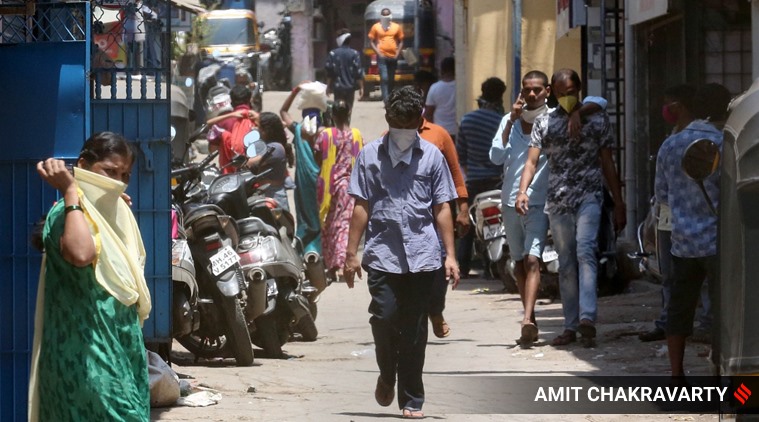 As a new phase of the lockdown with relaxations begins on Monday, 20 districts account for 68 per cent of the active COVID-19 cases in the country, the Centre has communicated to states. (Express File Photo by Amit Chakravarty)
As a new phase of the lockdown with relaxations begins on Monday, 20 districts account for 68 per cent of the active COVID-19 cases in the country, the Centre has communicated to states. (Express File Photo by Amit Chakravarty)
As a new phase of the lockdown with relaxations begins on Monday, 20 districts account for 68 per cent of the active COVID-19 cases in the country, the Centre has communicated to states. As many as 72 per cent of deaths from the disease have occurred in just 20 districts, state chief secretaries were told in a meeting chaired by the Cabinet Secretary on Sunday.
These districts cover major urban centres such as Mumbai, Ahmedabad, Delhi, Chennai and Pune among others. Significant overlaps are likely between the two sets of districts.
The union Ministry of Health and Family Welfare has deployed central public health teams to assist “state
health departments” in 72% deaths in 20 districts managing the outbreak in 20 districts that have the highest number of cases. These 20 districts were home to nearly 100 million people at the time of the 2011 Census.
“These teams shall report to the Addl Chief Secretary/Principal Secretary/Additional Secretary (Health) of respective states and assist state health department in implementation of containment measures for COVID-19 in affected areas within these districts/cities,” the Health Ministry’s order says.
“Eight districts are doubling faster than 10 days: Mumbai, Ahmedabad, Chennai, Central Delhi, Kolkata, North Delhi, Kanpur Nagar, Krishna,” said the presentation made at Sunday’s meeting. Seven districts have a higher case fatality rate than the India average of 3.2 per cent, the presentation said.
The case fatality rate (CFR) is the ratio of confirmed deaths to confirmed cases. These seven districts include major urban and industrial centres such as Mumbai, Pune, Ahmedabad, Indore, Surat, Central Delhi, and Krishna.
According to the presentation, nine districts, including Mumbai, Ahmedabad, Indore, Thane, Agra, Kurnool and Kolkata, have positivity rates that are “two times the India average (4.4%)”. Among the top 20 districts of concern with high numbers, nine are short on critical health infrastructure, the presentation said.
As lockdown 3.0 begins, 130 districts have been categorised in the red zone, 284 in orange, and 319 in green — the presentation noted that “states have flagged data related issues in zonal classification”. Sources said that in previous interactions, several states have protested against the number of red-zone districts. Some states have repeatedly asked that the power to classify should be delegated to them — the presentation, however, seemed to indicate that the Centre would not agree, though an attempt would be made to make the data more robust.
The presentation said that “going forward”, zonal classification would be done on “line list of patient data”. The Centre also requested all states to “remove mismatch of all testing data in ICMR portal”. States have also been asked to “update line listing of patient data, update outcome data(deaths, recoveries) and maintain health infrastructure data (isolation beds, oxygen beds, ICU beds) on COVID India portal as they impact district classification”.
In districts that have a high doubling rate, the Centre has suggested that states should employ field units to enforce social distancing, ensure rigorous contact tracing, counsel patients and contacts on the importance of following isolation and quarantine guidelines, and make sure that PPE kits and prophylaxis with hydroxychloroquine are made available if large numbers of health workers are infected.
In districts with high case fatality rates, the “suggested actions” include raising awareness through community action, and appointing “community volunteers/opinion leaders/religious leaders” for awareness and increased sampling. In areas where there is “poor healthcare seeking behaviour” such as delayed reporting of cases, the suggested actions include “intensify(ing) active case search, destigmatization of COVID 19”, ensuring well functioning helplines with adequate operational capacity, and advertising the helpline number.
Where there are “inadequate health care staff”, it has been suggested to “mobilize staff from different sources” including adjacent districts and private doctors on contractual basis, and explore the possibility of engaging retired professionals, final year students, and NGOs.